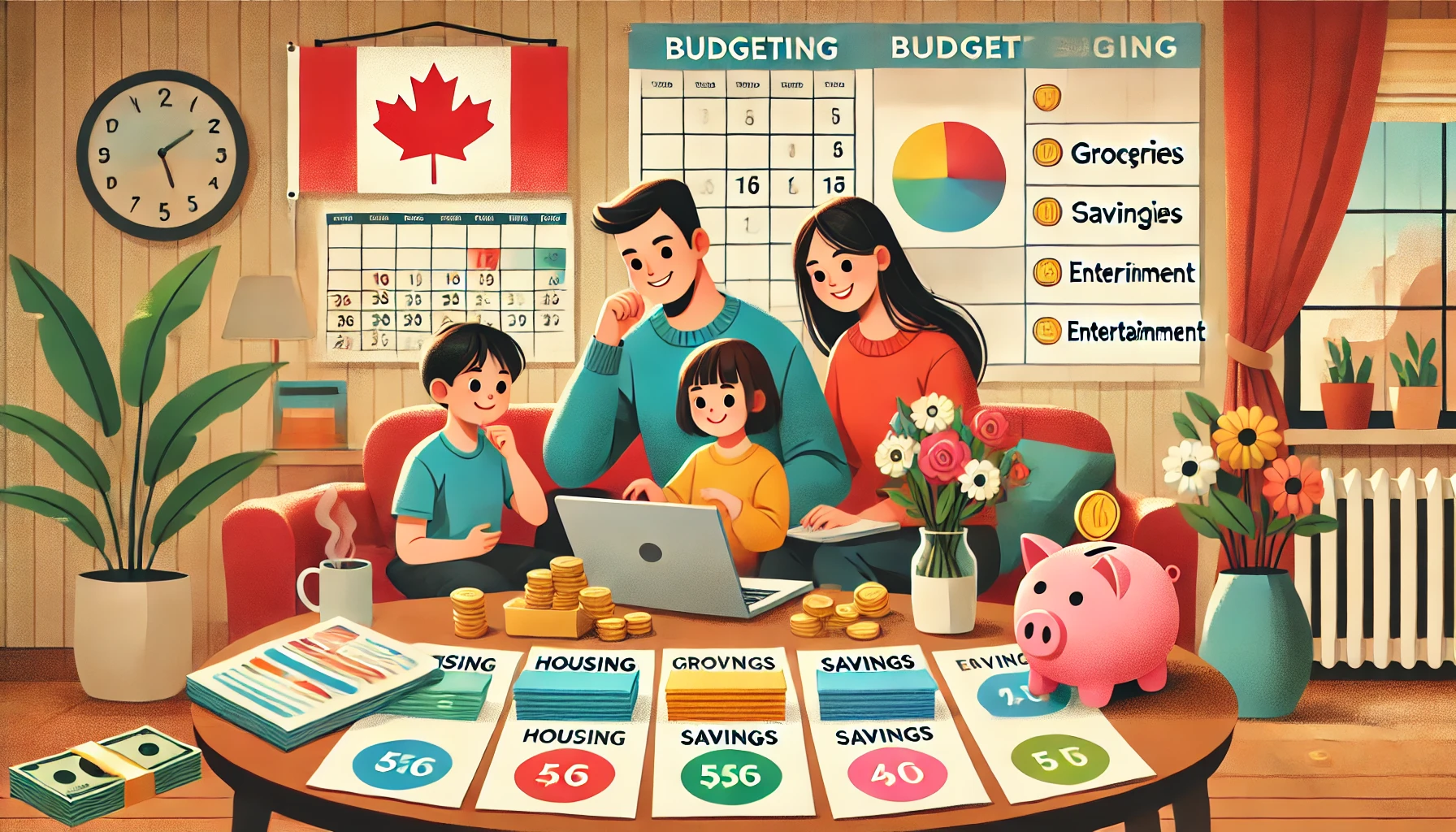For many Canadian families, managing household finances can feel like an overwhelming task. With rising costs of living, unpredictable expenses, and competing financial goals, creating and sticking to a budget is essential but challenging. A well-crafted family budget is more than just a tool for tracking spending; it’s a pathway to achieving financial stability, reducing stress, and ultimately, securing a better future for each family member.
This guide will walk Canadian families through the process of building an effective budget that fits their unique needs. From basic budgeting methods to practical, everyday strategies, we’ll explore ways to manage money that align with Canadian living costs, tax structures, and family goals like education savings, retirement, and homeownership.
Our aim is to demystify budgeting, making it accessible and manageable for every family. Whether you’re new to budgeting or looking to refine an existing plan, this guide will provide the insights and strategies you need to start and maintain a budget that truly works. You’ll learn about popular budgeting methods like the 50/30/20 and 70/20/10 rules, find tips on prioritizing expenses, and discover which approach is best suited for your family. With the right tools and a clear understanding, budgeting can transform from a source of stress into a practical way to support your family’s dreams and ambitions.
Understanding the Basics of Family Budgeting
A family budget is more than just a list of income and expenses; it’s a comprehensive plan that reflects a family’s values, goals, and priorities. It serves as a financial blueprint, helping families allocate resources effectively, prepare for unexpected challenges, and work toward shared aspirations like buying a home, funding a child’s education, or planning for retirement.
For Canadian families, budgeting is particularly important given the country’s unique financial landscape. Costs like housing, childcare, healthcare (beyond what’s covered provincially), and education can vary greatly depending on the region. Moreover, planning for goals such as RESP contributions for children’s education or leveraging tax-advantaged accounts like TFSAs and RRSPs adds another layer of complexity to family budgeting.
At its core, a budget has three primary goals:
- Control spending – Ensuring your family lives within its means and avoids unnecessary debt.
- Build savings – Preparing for emergencies, future goals, and retirement.
- Plan for the future – Balancing today’s needs with long-term aspirations.
The key to an effective family budget is alignment—it should reflect both the family’s financial realities and their collective values. This means involving all family members in the process, setting realistic expectations, and regularly reviewing the budget to ensure it continues to meet the family’s evolving needs.
Popular Budgeting Rules and Methods
Establishing a family budget doesn’t have to be complicated, thanks to tried-and-true budgeting methods that simplify the process. Two of the most popular approaches—the 50/30/20 rule and the 70/20/10 rule—offer structured ways to allocate income, making it easier to manage essential expenses, plan for future goals, and enjoy some of life’s small pleasures along the way.
The 50/30/20 Budgeting Rule
The 50/30/20 budgeting rule is a straightforward budgeting framework that divides after-tax income into three main categories:
- 50% for Needs: Essential expenses such as housing, groceries, utilities, transportation, and healthcare.
- 30% for Wants: Non-essential spending, like dining out, entertainment, and hobbies.
- 20% for Savings and Debt Repayment: Allocating funds to savings accounts, investments, and debt reduction.
This method is popular because it offers a balanced approach that prioritizes essential spending and future planning while allowing room for enjoyment. For Canadian families, adapting this rule might mean adjusting percentages based on regional costs, especially if essentials like housing consume more than 50% of income. Families can customize it by reducing the “wants” category slightly or boosting savings to reflect specific goals, like RESP contributions for children’s education.
The 70/20/10 Rule
For families facing higher living costs or debt obligations, the 70/20/10 rule may be a better fit:
- 70% for Living Expenses: Covering all necessary expenses, including housing, food, childcare, and transportation.
- 20% for Savings and Investments: Prioritizing long-term savings for retirement, children’s education, and emergency funds.
- 10% for Debt Repayment or Charitable Contributions: Addressing debt or setting aside funds for charitable giving.
This method can be particularly effective for families with higher essential expenses, as it dedicates a larger portion to day-to-day living costs. Canadian families, who may face high housing expenses or regional cost-of-living differences, may find this approach more realistic. Adapting it to your unique needs—like directing more towards debt if required—can help your family stay on track while preparing for the future.
Other Budgeting Techniques: The Envelope System & Zero-Based Budgeting
Beyond percentage-based methods, other techniques can help families with specific budgeting needs:
Envelope System
Traditionally, this involves allocating physical cash into envelopes labeled by category (e.g., groceries, entertainment). Once an envelope is empty, spending in that category stops until the next budget period. Though less common with digital transactions, modern apps allow you to implement a digital version of the envelope system. This method works well for families wanting a tangible way to control spending and is ideal for discretionary categories.
Zero-Based Budgeting
In this method, every dollar of income is assigned a purpose—whether for expenses, savings, or debt repayment—until there’s no leftover amount. This method forces a thorough evaluation of spending priorities and can be especially helpful for families with variable incomes. For Canadians, it’s a great way to incorporate seasonal expenses, RESP contributions, or RRSP savings, ensuring every dollar works purposefully.
Each method has its advantages, and choosing the right one depends on your family’s needs, income stability, and financial goals. Whether you opt for the structure of percentage-based rules or the hands-on approach of zero-based budgeting, a consistent plan can lead to financial stability and flexibility for your family.
Steps to Creating a Family Budget Plan
Creating a family budget might seem daunting, but breaking it down into manageable steps can simplify the process. A family budget plan offers a framework to allocate funds, track progress, and adjust as life circumstances evolve. Here’s a step-by-step guide to crafting a family budget that works for your unique situation.
Step 1: Assess Total Family Income
Start by identifying all income sources. This includes after-tax salaries, government benefits, child support payments, and any side income or investments. Canadian families should also consider any additional income from benefits like the Canada Child Benefit (CCB), which can be essential for family budgeting.
Knowing your total income provides a realistic view of what’s available for essential expenses, savings, and other goals.
Step 2: List and Categorize Expenses
Organize your expenses into three main categories: Essentials, Discretionary Spending, and Future Needs.
- Essentials: These are necessary, non-negotiable expenses such as rent or mortgage payments, groceries, utilities, transportation, and insurance.
- Discretionary Spending: This includes non-essential spending on things like dining out, entertainment, hobbies, and subscriptions. It’s where most adjustments can be made if needed.
- Future Needs: Allocations for emergency funds, debt repayment, retirement savings, and education savings. Contributions to Registered Education Savings Plans (RESPs) and Registered Retirement Savings Plans (RRSPs) should be included here.
Categorizing expenses makes it easier to understand spending patterns and identify areas where adjustments can improve the family’s financial health.
Step 3: Set Savings and Debt Goals
Establish savings goals tailored to your family’s needs, whether it’s building an emergency fund, saving for retirement, or funding future education costs. Canadian families should also consider allocating funds for RESP contributions to benefit from the Canada Education Savings Grant (CESG), which matches contributions up to a certain limit.
Debt repayment should also be prioritized based on interest rates and the overall impact on cash flow. High-interest debts, such as credit card balances, should be tackled first, as they can be costly over time.
Step 4: Organize the Budget Using a System
Choose a system to track your budget, whether it’s a digital app, a spreadsheet, or traditional pen and paper. Many families find that budgeting apps make it easier to track spending in real-time and adjust as needed. For Canadian families, options like YNAB (You Need a Budget), Mint, and PocketGuard are popular choices that offer customizations for unique family needs.
Using a system helps you monitor your progress and ensures that everyone in the family is aware of spending limits and goals.
Step 5: Track Progress and Adjust Regularly
A family budget is not a static plan. Commit to regular check-ins, whether monthly or quarterly, to review spending and make adjustments. This is especially important when income or expenses change, such as during a job transition, a family move, or a new addition to the family.
During these reviews, evaluate whether goals are being met and identify any categories where spending is consistently over or under budget. Adjustments might include reallocating funds to boost savings, cutting back on discretionary spending, or setting aside more for upcoming life events.
Creating Flexibility in the Budget
Life is unpredictable, and family expenses can vary greatly from month to month. Building some flexibility into your budget allows you to handle unexpected expenses without derailing your financial plan. Consider setting aside a small amount each month for a “buffer fund” to cover irregular expenses like car repairs, medical bills, or seasonal activities.
Involving the whole family in budgeting discussions can also be valuable. Children can learn the basics of money management, and parents can share family goals, making it a collective effort. This transparency builds trust and understanding, turning budgeting into a shared responsibility rather than a restriction.
Strategies for Managing and Sticking to the Family Budget
Building a budget is one thing—sticking to it is another. For many families, the challenge lies in managing unexpected expenses and resisting the temptation to overspend on non-essential items. Fortunately, there are practical strategies to help families stay disciplined and make the most of their financial plan. This section will explore ways to reduce discretionary spending, handle surprises, and maintain financial consistency over the long term.
1. Set Clear Priorities and Distinguish Needs from Wants
The first step to staying on budget is distinguishing between essential needs and non-essential wants. Essentials—such as housing, groceries, transportation, and healthcare—should always be prioritized in your budget. Wants, which include entertainment, dining out, and hobbies, can be trimmed or adjusted if expenses start to exceed the budget.
Canadian families, in particular, might also consider educational savings as a priority need. Setting clear categories makes it easier to allocate funds appropriately and make informed decisions if adjustments are required.
2. Involve the Family in Budgeting Conversations
Involving the whole family in budget discussions can create a sense of shared responsibility and help everyone understand financial limits. Setting clear family goals—like saving for a vacation, contributing to children’s education, or paying off debt—gives everyone a stake in budgeting success.
Consider holding monthly “budget meetings” to discuss spending patterns, celebrate successes, and identify areas for improvement. This is also a great time to check in with children on their spending habits and teach them valuable financial lessons in a practical, real-world context.
3. Reduce Discretionary Spending with Simple Adjustments
Discretionary spending is often the most flexible area in a family budget and the easiest place to cut back when necessary. Here are some tips to manage it without feeling deprived:
- Meal Planning: Planning meals in advance can reduce grocery costs and minimize food waste. Preparing meals at home instead of dining out saves money and allows for healthier choices.
- Use Rewards and Loyalty Programs: Many Canadian stores and service providers offer loyalty programs that provide discounts, cash back, or points on purchases. Leveraging these programs can lead to significant savings over time.
- Embrace Frugality in Entertainment: Look for budget-friendly or free entertainment options, such as community events, outdoor activities, or library programs, which offer quality family time without the high cost.
4. Prepare for Unexpected Expenses with an Emergency Fund
Life is full of surprises, and unexpected expenses can quickly derail a family budget. Building an emergency fund is essential to protect your budget from unplanned costs like car repairs, medical expenses, or urgent home repairs.
Experts generally recommend setting aside three to six months’ worth of essential expenses in an emergency fund. Canadian families may also benefit from keeping this fund in a Tax-Free Savings Account (TFSA) for easy access and tax-free growth. A fully funded emergency fund provides peace of mind and keeps long-term savings goals intact, even when unexpected expenses arise.
5. Automate Savings and Bill Payments
Automation is one of the simplest ways to stay consistent with budgeting goals. Setting up automatic transfers to savings accounts ensures that a portion of income goes directly toward financial goals without the temptation to spend it.
Consider automating bill payments as well to avoid late fees and ensure essentials like utilities, rent, and insurance are covered. Many Canadian banks offer tools to set up recurring transfers to savings or investment accounts, making it easier to prioritize savings without added effort.
6. Regularly Review and Adjust the Budget
A budget isn’t static—it should evolve as family needs and financial situations change. Regularly reviewing the budget allows you to track progress, adjust for any income or expense changes, and ensure you’re still on track to meet financial goals.
Monthly reviews can highlight areas where spending may have exceeded the budget or reveal unexpected savings. Annual reviews are also helpful for assessing long-term progress, especially with goals like RESP contributions or retirement savings. If you find certain categories consistently over or under budget, don’t be afraid to reallocate funds to better reflect your family’s current priorities.
7. Plan for Major Expenses with Sinking Funds
For large, anticipated expenses like vacations, holiday spending, or home repairs, consider setting up a “sinking fund.” This is a separate savings account where you set aside a small amount each month for specific upcoming costs.
Sinking funds help distribute the financial impact of larger purchases over several months, making it easier to handle big expenses without straining the monthly budget. For example, Canadian families planning an annual summer trip or holiday season spending can set aside a small portion each month to avoid large, one-time financial hits.
8. Reward Progress and Celebrate Milestones
Budgeting requires discipline, so it’s essential to recognize and celebrate your family’s progress. Whether you’ve reached a savings goal, paid down debt, or simply stuck to the budget for several months, celebrating these milestones can be motivating.
Consider setting small rewards for hitting financial goals, like a family outing or a special meal. Celebrating budgeting achievements fosters a positive attitude toward money management and keeps everyone motivated to stick to the plan.
Prioritizing Expenses in a Family Budget
Prioritizing expenses is one of the most crucial steps in creating and maintaining a family budget. Not all expenses carry equal weight, and allocating funds strategically ensures that your family’s most important needs are met while still allowing room for savings and discretionary spending. This section will guide you through determining financial priorities, balancing needs and wants, and allocating funds effectively.
1. Focus on Essentials First
Essentials are the foundation of any family budget. These are the non-negotiable expenses that keep your household running. For Canadian families, the primary essential categories include:
- Housing: Rent or mortgage payments, property taxes, and insurance. Aim to keep housing costs at or below 30% of your household income.
- Groceries: Food is a significant budget category, but meal planning and mindful shopping can help control costs.
- Transportation: Include car payments, insurance, fuel, and public transit costs.
- Utilities: Electricity, water, heating, internet, and phone services.
- Healthcare: Prescription medications, dental care, and supplemental health insurance not covered by provincial plans.
By prioritizing these essentials, you can ensure your family’s basic needs are met before addressing other spending areas.
2. Build and Maintain Savings
After essentials, savings should be the next priority in your budget. While it can be tempting to spend leftover income on non-essentials, consistent savings habits are key to long-term financial stability. Focus on three main savings goals:
- Emergency Fund: Aim for three to six months’ worth of essential expenses. Consider using a Tax-Free Savings Account (TFSA) for this purpose.
- Retirement Savings: Regular contributions to an RRSP or workplace pension plan help secure your financial future.
- Education Savings: If you have children, contributing to a Registered Education Savings Plan (RESP) allows you to benefit from government matching grants through the Canada Education Savings Grant (CESG).
Savings not only prepare you for unexpected events but also build a foundation for achieving long-term family goals.
3. Balance Wants with Discretionary Spending
Discretionary spending includes all non-essential expenses, such as entertainment, dining out, hobbies, and vacations. While it’s important to enjoy life and spend on things that bring happiness, these expenses should always come after essentials and savings.
The key to balancing discretionary spending is setting a realistic limit. Use the 50/30/20 or 70/20/10 rule as a guideline, and monitor these expenses closely. If your family finds itself overspending in this category, consider using strategies like:
- Opting for free or low-cost family activities.
- Limiting takeout or restaurant visits to once a month.
- Setting a monthly spending cap for hobbies or personal treats.
4. Pay Down Debt Strategically
Debt repayment is another critical priority, especially if your family has high-interest debt, such as credit card balances or payday loans. The faster these debts are paid off, the less interest you’ll pay in the long run, freeing up more money for savings and other goals.
Consider the following strategies for managing debt:
- Debt Snowball Method: Focus on paying off smaller debts first to build momentum.
- Debt Avalanche Method: Tackle debts with the highest interest rates first to minimize overall costs.
- Consolidation or Refinancing: Explore consolidating debts into a single loan with a lower interest rate, which can simplify payments and save money.
5. Plan for Irregular and Seasonal Expenses
Irregular expenses, such as holiday spending, back-to-school costs, or annual insurance premiums, can throw a budget off track if not planned for. Creating a sinking fund for these predictable but irregular costs ensures they’re accounted for without impacting your monthly budget.
Examples of seasonal expenses for Canadian families include:
- Winter clothing and gear for children.
- Holiday gifts and celebrations.
- Summer camps or extracurricular activities.
6. Define an Ideal Budget for Your Family
An ideal family budget varies based on income, family size, and regional factors. For a typical Canadian family of four, a reasonable budget might look like this:
- Housing: 25–30% of income
- Groceries: 10–15% of income
- Transportation: 10–15% of income
- Savings and Debt Repayment: 20–30% of income
- Discretionary Spending: 10–20% of income
Adjust these percentages based on your family’s specific circumstances. For example, if housing costs are high in your region, you may need to allocate a larger percentage to housing and reduce discretionary spending.
7. Prioritize What Matters Most
Every family is unique, and priorities will differ depending on your stage of life and financial goals. For instance:
- A young family might prioritize building an emergency fund and contributing to an RESP.
- A family nearing retirement might focus on maximizing RRSP contributions and paying off remaining debt.
- Families with limited income might focus on controlling expenses and building small, consistent savings.
The most important aspect of prioritizing is aligning your budget with your family’s values and goals. By clearly defining what matters most, you can make informed financial decisions that support your family’s well-being.
Conclusion: The Golden Rules of Budgeting for Families
Budgeting is more than just a financial exercise—it’s a tool for creating stability, achieving goals, and fostering a sense of security for your family. By taking the time to plan, prioritize, and track your finances, you can build a roadmap to support both your family’s immediate needs and long-term aspirations. Here are the key takeaways to guide your family’s budgeting journey:
1. Spend Less Than You Earn
The number one rule of budgeting is simple: ensure your expenses are lower than your income. This creates room for savings, reduces reliance on debt, and sets the stage for financial stability.
2. Prioritize Essentials
Always focus on covering your family’s basic needs—housing, food, transportation, and healthcare—before allocating money to discretionary spending. Essentials form the foundation of a sustainable budget.
3. Save Consistently
Savings are the cornerstone of financial resilience. Whether you’re building an emergency fund, contributing to an RESP for your children’s education, or preparing for retirement, consistent saving is crucial for achieving your goals.
4. Adjust as Life Changes
Life is dynamic, and so is your family’s financial situation. Regularly review your budget to account for changes like a new family member, a job transition, or increased expenses. Flexibility is key to keeping your budget relevant and effective.
5. Involve the Entire Family
Make budgeting a collaborative effort by involving all family members. This not only helps align spending with shared goals but also teaches valuable financial skills to children.
6. Use Tools and Resources
Leverage technology and financial tools to simplify the budgeting process. Apps, spreadsheets, and calculators tailored to Canadian families can help track expenses and savings in real-time.
Resources for Canadian Families
To further support your budgeting efforts, explore these Canadian-specific resources:
- Government Programs: Learn about benefits like the Canada Child Benefit (CCB) or the Canada Education Savings Grant (CESG) for RESP contributions.
- Budgeting Apps: Tools like YNAB, Mint, and PocketGuard can streamline tracking and goal setting.
- Financial Education: Free courses and resources from organizations like the Financial Consumer Agency of Canada (FCAC) provide valuable insights into managing money.



